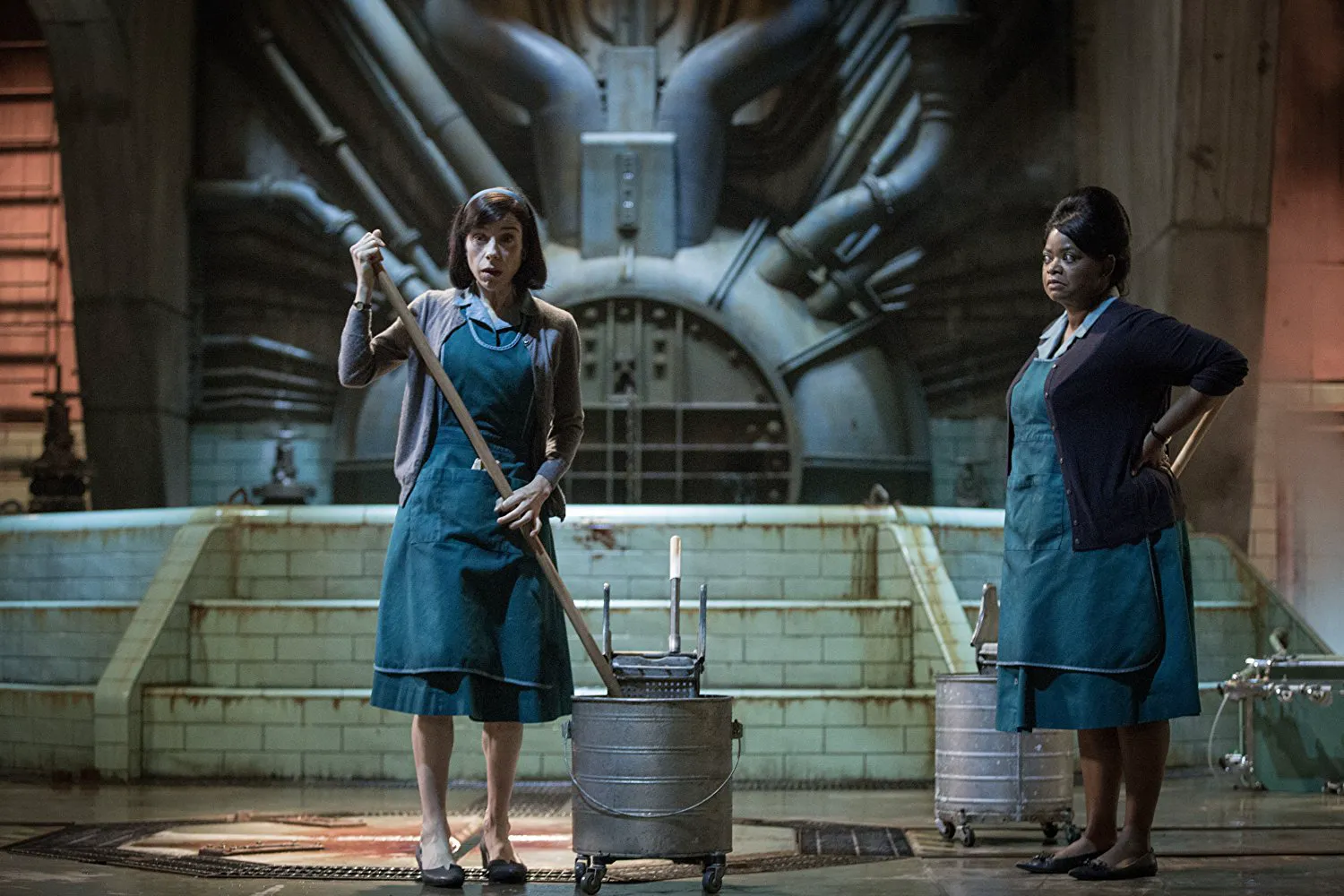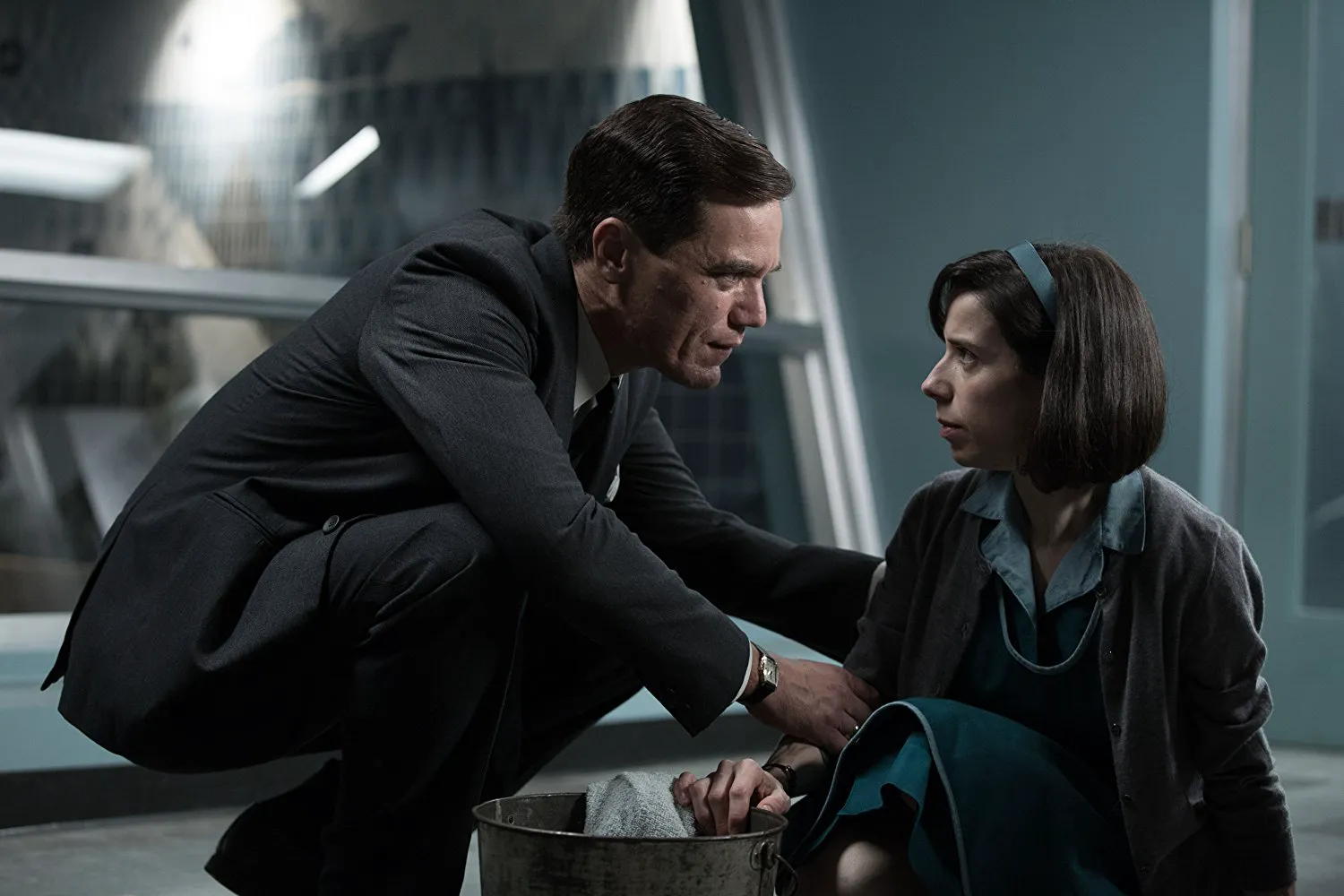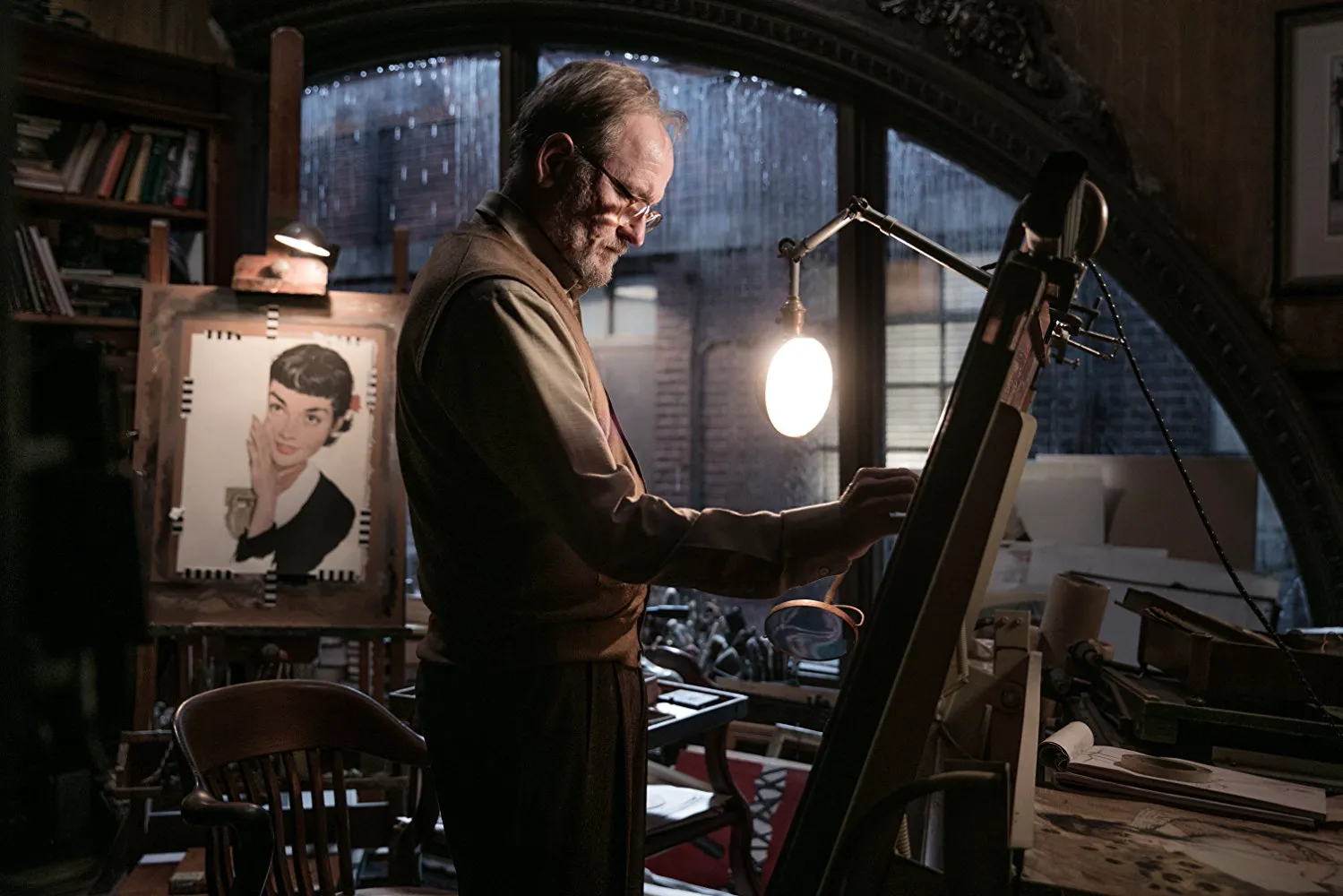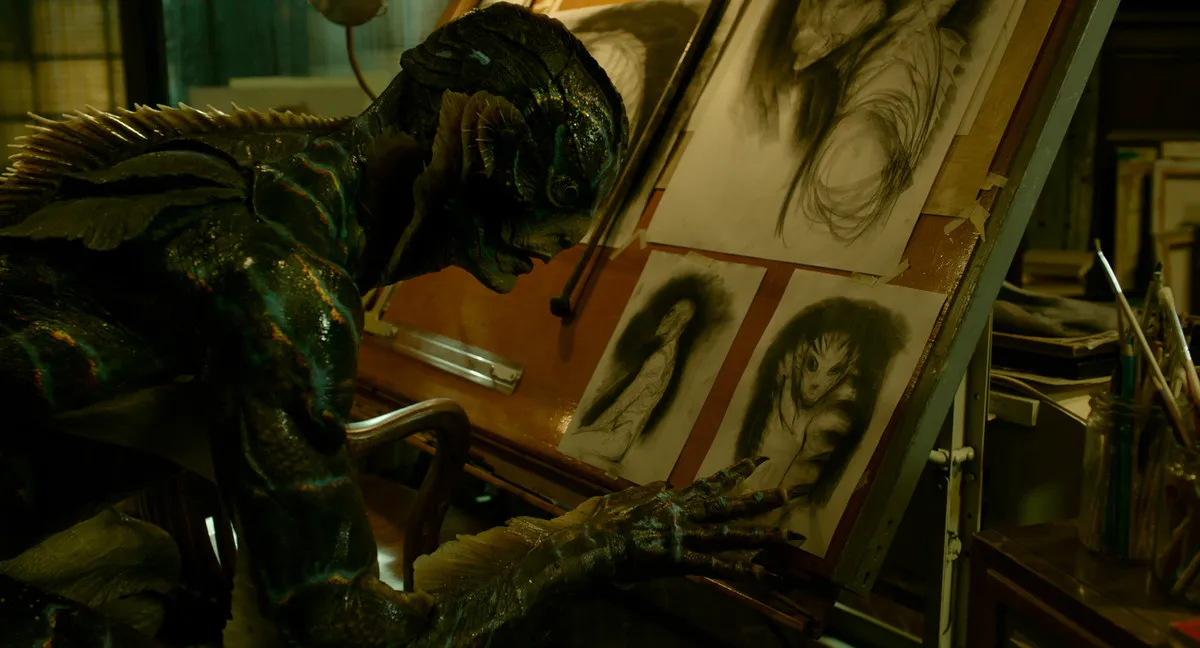The Shape of Water: A Fairy Tale for Adults?
A simple story that diligently exploits touching fairy-tale motifs and a retro atmosphere about a monster that awakens the basic instinct in everyone.
The post-war years in the USA. In the race to conquer space, Americans stop at nothing, even experimenting on a mysterious humanoid creature, breathing through gills, caught in the Amazon. While a lively discussion is underway in a secret laboratory about whether to gut the monster and study the structure of its respiratory organs or better to leave it alive, Eliza, a mute cleaner who loves music and cinema, finds a common language with the mysterious creature. Deeply concerned about the fate of her unexpected new friend, the girl organizes the abduction of the monster from the most guarded secret facility in the United States.

There’s no arguing that Guillermo Del Toro is one of the most inventive storytellers in world cinema today. Each new film of his is an incredible world, thought out to the smallest detail, with its own style, atmosphere, and color, filled with amazing creatures. At the same time, in his films, the Mexican genius talks about simple things – about fear, about growing up, about kindness, love, and the willingness to fight for one’s happiness. This is wonderful, but there is something that does not allow Del Toro to be put on a par with Steven Spielberg, Robert Zemeckis, George Lucas, or even Tim Burton – the author of “Hellboy” and “Pacific Rim” is, of course, a brilliant artist and architect of his cinematic worlds, but he is not a very graceful inventor of plots, in fact, his films are dramatically unpretentious and take exclusively visual luxury.

“The Shape of Water” – the triumphant film of the Venice Film Festival and the recent Golden Globe ceremony – is perhaps the simplest in Del Toro’s filmography, a more naive plot, perhaps, only in the film about the battle of Jaegers and Kaiju. Critics who rushed to compare “The Shape” with Chebotarev and Kazansky’s “Amphibian Man” frankly flattered Hollywood – the Soviet film half a century ago is far from the depths of Alexander Belyaev, but even this charming trinket with young Korenev, Vertinskaya, and Kozakov in the lead roles gives a hundred points ahead of Del Toro’s film. The plot of “The Shape” is even somehow embarrassing to retell – the villains caught an innocent creature and began to torture it, but there was a compassionate woman who saved the monster and even began to live with it. Last year’s “Beauty and the Beast” is exactly about the same thing. And hundreds and hundreds of other works.

Despite the fact that the roles in the film were written for specific actors, Guillermo Del Toro failed to get everyone he planned to attract to his film. For example, Richard Jenkins replaced Ian McKellen, who refused to shoot.
Of course, Del Toro makes an attempt to dilute the straightforward plot with touching branches that are helpless in their own way – here, Soviet KGB spies are involved, and a worthless artist suffering from baldness, and a cruel security chief basking in his impunity, and even such topical issues of racism and domestic violence are touched upon today. However, all this looks strange and uncertain, as if Vanessa Taylor’s script was forcibly stretched, adding more water to it, literally and figuratively, especially ridiculous are the intrusive inserts of frames of classical paintings, the emphasis on touching music, and the scene with song and dance. This only emphasizes the overall plot helplessness, and from the banal ending, there is no other feeling than bewilderment.

It took three hours every day to dress Doug Jones in the makeup and equipment of a sea monster. According to the actor, it was the most difficult costume he had to try on in Guillermo Del Toro’s films.
However, in the visual part and acting performance, “The Shape of Water” is almost impeccable. Yes, Sally Hawkins, Octavia Spencer, and Michael Shannon are forced to huddle in very cramped predictable images, but they give themselves to the game without reservation and make their characters as convex as possible: if cruelty, then so villainous that fingers fall off, if kindness, then such that bullets stop. And there is no need to talk about the magical atmosphere of the 1960s – Del Toro, like no other, knows how to create beauty from the most ordinary things, and turn unusual structures into fabulous decorations, filled with secrets and surprises.
And moreover, you can’t get away from the intrusive demonstration of reverence for classical cinema, peplums, the spirit of event films, shown by the director throughout the film. It turned out a little “thicker” than in “The Artist” or “Hugo”, the homage turned out to be somewhat far-fetched, but here it is, as they say, beautiful, firstly, secondly, and thirdly. Unfortunately, behind the beauty in Del Toro’s “The Shape of Water” there is emptiness and a colorless liquid in which there is nothing to grab onto. Naive for a fairy tale, predictable for a drama, simple for a thriller – water, in a word.
“The Shape of Water”: A Deep Dive into Del Toro’s Latest Fantasy
Guillermo del Toro’s “The Shape of Water” is a film that wears its heart on its sleeve, a modern fairy tale steeped in retro charm. It tells the story of a creature from the Amazon, a humanoid amphibian, and the unlikely bond it forms with a mute cleaning lady in a 1960s American research facility. But is the film’s visual splendor enough to elevate it beyond its familiar narrative?
A Familiar Tale, Beautifully Told
Del Toro, a master of visual storytelling, crafts a world that is both fantastical and grounded. The film’s aesthetic is undeniably captivating, filled with lush colors, intricate details, and a palpable sense of wonder. However, the plot itself treads well-worn territory. The “Beauty and the Beast” trope is readily apparent, and comparisons to the Soviet-era “Amphibian Man” are inevitable.
The Story
In the heart of Cold War-era America, a secret government laboratory becomes the unlikely stage for a poignant love story. Eliza, a mute cleaning woman, discovers a captured amphibian creature and forms a deep connection with it. As she learns more about the creature’s plight, she becomes determined to rescue it from the clutches of the ruthless scientists who seek to exploit it.
Visuals and Performances Shine
While the narrative may lack originality, “The Shape of Water” excels in its visual execution and the performances of its cast. Sally Hawkins delivers a captivating performance as Eliza, conveying a range of emotions without uttering a single word. Octavia Spencer and Michael Shannon also shine in their respective roles, adding depth and complexity to the film’s supporting characters.
A Missed Opportunity?
Despite its strengths, “The Shape of Water” ultimately falls short of its potential. The film’s attempts to address social issues such as racism and domestic violence feel somewhat forced and underdeveloped. The ending, while visually stunning, lacks the emotional resonance that one might expect from a fairy tale.
Conclusion
“The Shape of Water” is a visually stunning and well-acted film that offers a modern take on a classic fairy tale. However, its familiar narrative and underdeveloped themes prevent it from reaching its full potential. While it may not be Del Toro’s most groundbreaking work, it is nonetheless a captivating and thought-provoking film that is sure to leave a lasting impression.